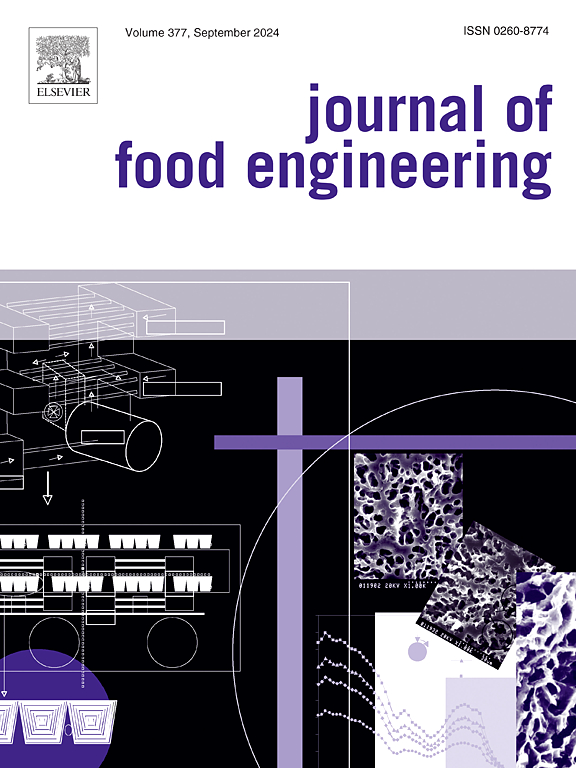魔芋葡甘露-琼脂杂化水凝胶的制备及特性研究
IF 5.8
2区 农林科学
Q1 ENGINEERING, CHEMICAL
引用次数: 0
摘要
以魔芋葡甘露聚糖(KG)和琼脂(AG)为原料制备了一种高效吸附酪蛋白水解产物多肽的复合水凝胶。以不同浓度的KG和AG配制水凝胶基质,并根据形貌、结构性能、流变行为和力学特性确定最佳组成。在试验配方中,2.5% KG和1.5% AG (2.5KG-1.5AG)的水凝胶凝胶强度、凝胶含量、溶胀指数和硬度均显著高于3.0KG-1.0AG的水凝胶配方。此外,2.5KG-1.5AG具有更有利的表面特性,包括均匀的多孔结构,更大的表面积,增强的肽吸附能力。该配方对150 mg/L酪蛋白水解液中多肽的最大吸附量为113.59 mg/g。吸附动力学遵循准二级动力学模型,表明吸附机理为化学吸附,而Freundlich等温线表明在非均质表面上有多层吸附。此外,2.5KG-1.5AG具有优异的解吸性能(93%),表明其具有可重复使用和操作稳定性的潜力。这些发现证实了KG-AG杂交水凝胶是一种有效的、可持续的生物基多肽选择性分离吸附剂。其成本效益、高吸附能力和显著的可重复使用性支持其在食品级生物活性肽富集和纯化系统中的适用性。本文章由计算机程序翻译,如有差异,请以英文原文为准。
Development and characterization of konjac glucomannan–agar hybrid hydrogels for peptide adsorption from casein hydrolysate
A hybrid hydrogel composed of konjac glucomannan (KG) and agar (AG) was developed for the efficient adsorption of peptides derived from casein hydrolysate. Hydrogel matrix was formulated with different concentrations of KG and AG, and the optimal composition was determined on the basis of morphologies, structural properties, rheological behaviors, and mechanical characteristics. Among the tested formulations, the hydrogel containing 2.5 % KG and 1.5 % AG (2.5KG-1.5AG) exhibited significantly higher gel strength, gel content, swelling index, and hardness compared to the 3.0KG-1.0AG formulation. Moreover, 2.5KG-1.5AG exhibited more favorable surface characteristics, including a uniform porous structure, larger surface area, and enhanced peptide adsorption capacity. This formulation achived a maximum peptide adsorption capacity of 113.59 mg/g for peptides from a 150 mg/L casein hydrolysate solution. Adsorption kinetics followed a pseudo-second-order kinetics model, implying a chemisorption mechanism, while Freundlich isotherm suggested multilayer adsorption on a heterogeneous surface. In addition, 2.5KG-1.5AG showed excellent desorption properties (>93 %), suggesting its potential for reusability and operational stability. These findings confirm that the KG–AG hybrid hydrogel represents an effective and sustainable bio-based adsorbent for the selective separation of peptides. Its cost-efficiency, high adsorption capacity, and remarkable reusability support its applicability in food-grade bioactive peptide enrichment and purification systems.
求助全文
通过发布文献求助,成功后即可免费获取论文全文。
去求助
来源期刊

Journal of Food Engineering
工程技术-工程:化工
CiteScore
11.80
自引率
5.50%
发文量
275
审稿时长
24 days
期刊介绍:
The journal publishes original research and review papers on any subject at the interface between food and engineering, particularly those of relevance to industry, including:
Engineering properties of foods, food physics and physical chemistry; processing, measurement, control, packaging, storage and distribution; engineering aspects of the design and production of novel foods and of food service and catering; design and operation of food processes, plant and equipment; economics of food engineering, including the economics of alternative processes.
Accounts of food engineering achievements are of particular value.
 求助内容:
求助内容: 应助结果提醒方式:
应助结果提醒方式:


